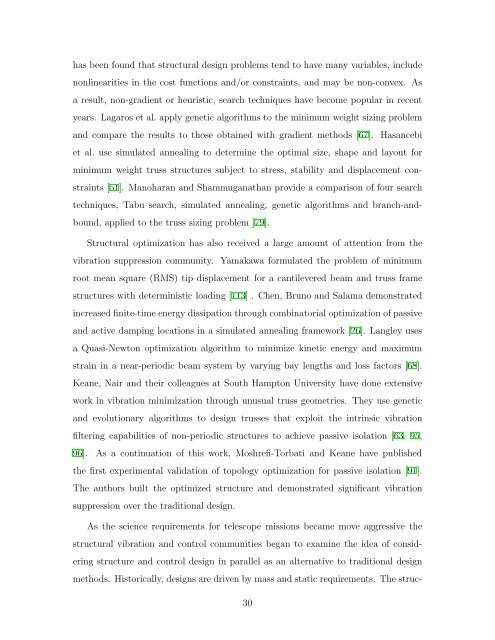Chapter 5 Robust Performance Tailoring with Tuning - SSL - MIT
Chapter 5 Robust Performance Tailoring with Tuning - SSL - MIT
Chapter 5 Robust Performance Tailoring with Tuning - SSL - MIT
You also want an ePaper? Increase the reach of your titles
YUMPU automatically turns print PDFs into web optimized ePapers that Google loves.
has been found that structural design problems tend to have many variables, include<br />
nonlinearities in the cost functions and/or constraints, and may be non-convex. As<br />
a result, non-gradient or heuristic, search techniques have become popular in recent<br />
years. Lagaros et al. apply genetic algorithms to the minimum weight sizing problem<br />
and compare the results to those obtained <strong>with</strong> gradient methods [67]. Hasancebi<br />
et al. use simulated annealing to determine the optimal size, shape and layout for<br />
minimum weight truss structures subject to stress, stability and displacement con-<br />
straints [51]. Manoharan and Shammuganathan provide a comparison of four search<br />
techniques, Tabu search, simulated annealing, genetic algorithms and branch-and-<br />
bound, applied to the truss sizing problem [79].<br />
Structural optimization has also received a large amount of attention from the<br />
vibration suppression community. Yamakawa formulated the problem of minimum<br />
root mean square (RMS) tip displacement for a cantilevered beam and truss frame<br />
structures <strong>with</strong> deterministic loading [113] . Chen, Bruno and Salama demonstrated<br />
increased finite-time energy dissipation through combinatorial optimization of passive<br />
and active damping locations in a simulated annealing framework [26]. Langley uses<br />
a Quasi-Newton optimization algorithm to minimize kinetic energy and maximum<br />
strain in a near-periodic beam system by varying bay lengths and loss factors [68].<br />
Keane, Nair and their colleagues at South Hampton University have done extensive<br />
work in vibration minimization through unusual truss geometries. They use genetic<br />
and evolutionary algorithms to design trusses that exploit the intrinsic vibration<br />
filtering capabilities of non-periodic structures to achieve passive isolation [63, 95,<br />
96]. As a continuation of this work, Moshrefi-Torbati and Keane have published<br />
the first experimental validation of topology optimization for passive isolation [91].<br />
The authors built the optimized structure and demonstrated significant vibration<br />
suppression over the traditional design.<br />
As the science requirements for telescope missions became move aggressive the<br />
structural vibration and control communities began to examine the idea of consid-<br />
ering structure and control design in parallel as an alternative to traditional design<br />
methods. Historically, designs are driven by mass and static requirements. The struc-<br />
30







